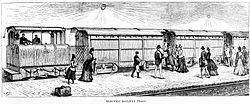| Part of a series on the |
| London Underground |
|---|
 |
The transport system now known as the London Underground began in 1863 with the Metropolitan Railway, the world's first underground railway. Over the next forty years, the early sub-surface lines reached out from the urban centre of the capital into the surrounding rural margins, leading to the development of new commuter suburbs. At the turn of the nineteenth century, new technology—including electric locomotives and improvements to the tunnelling shield—enabled new companies to construct a series of "tube" lines deeper underground. Initially rivals, the tube railway companies began to co-operate in advertising and through shared branding, eventually consolidating under the single ownership of the Underground Electric Railways Company of London (UERL), with lines stretching across London.
Contents
- 1820s
- 1840s
- 1850s
- 1860s
- 1870s
- 1880s
- 1890s
- 1900s
- 1910s
- 1920s
- 1930s
- 1940s
- 1950s
- 1960s
- 1970s
- 1980s
- 1990s
- 2000s
- 2010s
- 2020s
- See also
- References
- Citations
- Sources
In 1933, the UK Government amalgamated the UERL and the Metropolitan Railway as a single organisation, named the London Passenger Transport Board. The London Underground has since passed through a series of administrations, expanding further by the construction of new extensions and through the acquisition of existing main line routes, culminating in its current form as part of Transport for London, the capital's current transport administration, controlled by the Greater London Authority.
This timeline lists significant dates in the history of the network. Station names shown are current names; many stations have previously had different names.
| Contents |
|---|
1820s 1840s 1850s 1860s 1870s 1880s 1890s 1900s 1910s 1920s 1930s 1940s 1950s 1960s 1970s 1980s 1990s 2000s 2010s 2020s |











